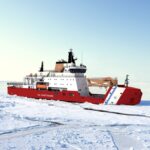
A recent month-long Coast Guard evaluation of commercially available unmanned surface vehicles (USVs) off the Coast of Hawaii demonstrated the effectiveness of the technology as a force multiplier in helping to carry out maritime domain awareness (MDA) missions in remote ocean areas but further advances are necessary, the Coast Guard said on Monday. The initial results from the evaluation showed that the USVs can provide “some level of daytime MDA” over an extended period but onboard artificial intelligence and machine…

 By
By 











